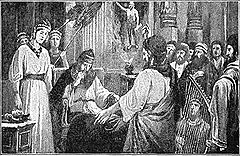Quick Facts
Biography
Nebuchadnezzar II (from Akkadian 𒀭𒀝𒆪𒁺𒌨𒊑𒋀 Nabû-kudurri-uṣur), meaning "O god Nabu, preserve/defend my firstborn son") was king of Babylon c. 605 BC – c. 562 BC, the longest reign of any king of the Neo-Babylonian empire.
Career


Nebuchadnezzar was the eldest son and successor of Nabopolassar, an Assyrian official who rebelled and established himself as king of Babylon in 620 BC; the dynasty he established ruled until 539 BC, when the Neo-Babylonian Empire was conquered by Cyrus the Great. Nebuchadnezzar is first mentioned in 607 BC, during the destruction of Babylon's arch-enemy Assyria, at which point he was already crown prince. In 605 BC he and his ally Cyaxares, ruler of the Medes and Persians, led an army against the Assyrians and Egyptians, who were then occupying Syria, and in the ensuing Battle of Carchemish, Necho II was defeated and Syria and Phoenicia were brought under the control of Babylon.
Nabopolassar died in August 605 BC, and Nebuchadnezzar returned to Babylon to ascend the throne. For the next few years his attention was devoted to subduing his eastern and northern borders, and in 594/5 BC there was a serious but brief rebellion in Babylon itself. In 594/3 BC the army was sent again to the west, possibly in reaction to the elevation of Psammetichus II to the throne of Egypt. King Zedekiah of Judah attempted to organise opposition among the small states in the region, but his capital, Jerusalem, was taken in 587 BC (the events are described in the Bible's Books of Kings and Book of Jeremiah). In the following years Nebuchadnezzar incorporated Phoenicia and the former Assyrian provinces of Cilicia (southwestern Anatolia) into his empire and may have campaigned in Egypt. In his last years Nebuchadnezzar seems to have begun behaving irrationally, "pay[ing] no heed to son or daughter," and was deeply suspicious of his sons. The kings who came after him ruled only briefly and Nabonidus, apparently not of the royal family, was overthrown by the Persian conqueror Cyrus the Great less than twenty-five years after Nebuchadnezzar's death.
The ruins of Nebuchadnezzar's Babylon are spread over two thousand acres, forming the largest archaeological site in the Middle East. He enlarged the royal palace (including in it a public museum, possibly the world's first), built and repaired temples, built a bridge over the Euphrates, and constructed a grand processional boulevard (the Processional Way) and gateway (the Ishtar Gate) lavishly decorated with glazed brick. Each Spring equinox (the start of the New Year) the god Marduk would leave his city temple for a temple outside the walls, returning through the Ishtar Gate and down the Processional Way, paved with coloured stone and lined with molded lions, amidst rejoicing crowds.
Portrayal in the Bible

Nebuchadnezzar is an important character in the Book of Daniel, a collection of legendary tales and visions dating from the 2nd century BC. The consensus among scholars is that Daniel never existed and was apparently chosen for the hero of the book because of his traditional reputation as a wise seer. Daniel 1 introduces Nebuchadnezzar as the king who takes Daniel and other Jewish youths into captivity in Babylon, there to be trained in the magical arts. Through the help of his god Yahweh Daniel excels in his studies, and the second year of Nebuchadnezzar's reign he interprets the king's dream of a huge image as God's omen of the rise and fall of world powers, starting with Nebuchadnezzar's kingdom. (Daniel 2). In Daniel 3 Nebuchadnezzar admits the power of the god of the Jews when Yahweh saves three of Daniel's companions from a fiery furnace, and in Daniel 4 a bout of madness forces Nebuchadnezzar again to admit the power of Yahweh.
The Book of Jeremiah contains a prophecy about Nebuchadnezzar as the "destroyer of nations" (Jer. 4:7) and gives an account of the siege of Jerusalem and the looting and destruction of the temple (Jer. 52).
Portrayal in medieval Muslim sources
According to Tabari, Nebuchadnezzar, whose Persian name was Bukhtrashah, was of Persian descent, from the progeny of Jūdharz, however modern scholars are unanimous that he was either a native Mesopotamian (Assyrian-Babylonian) or a Chaldean . Some medieval writers erroneoulsly believed he lived as long as 300 years. While much of what is written about Nebuchadnezzar depicts a ruthless warrior, some texts describe a ruler who was concerned with both spiritual and moral issues in life and was seeking divine guidance.
Nebuchadnezzar was seen as a strong, conquering force in Islamic texts and historical compilations, like Tabari. The Babylonian leader used force and destruction to grow an empire. He conquered kingdom after kingdom, including Phoenicia, Philistia, Judah, Ammon, Moab, and more. The most notable events that Tabari’s collection focuses on is the destruction of Jerusalem.
